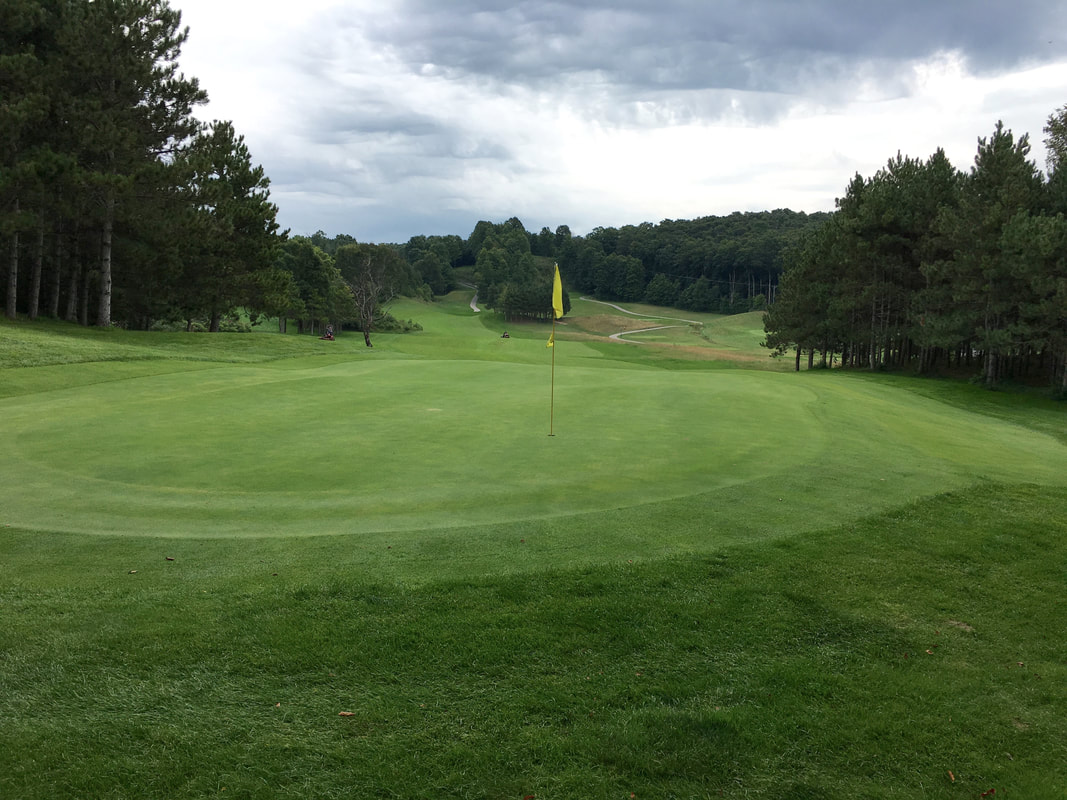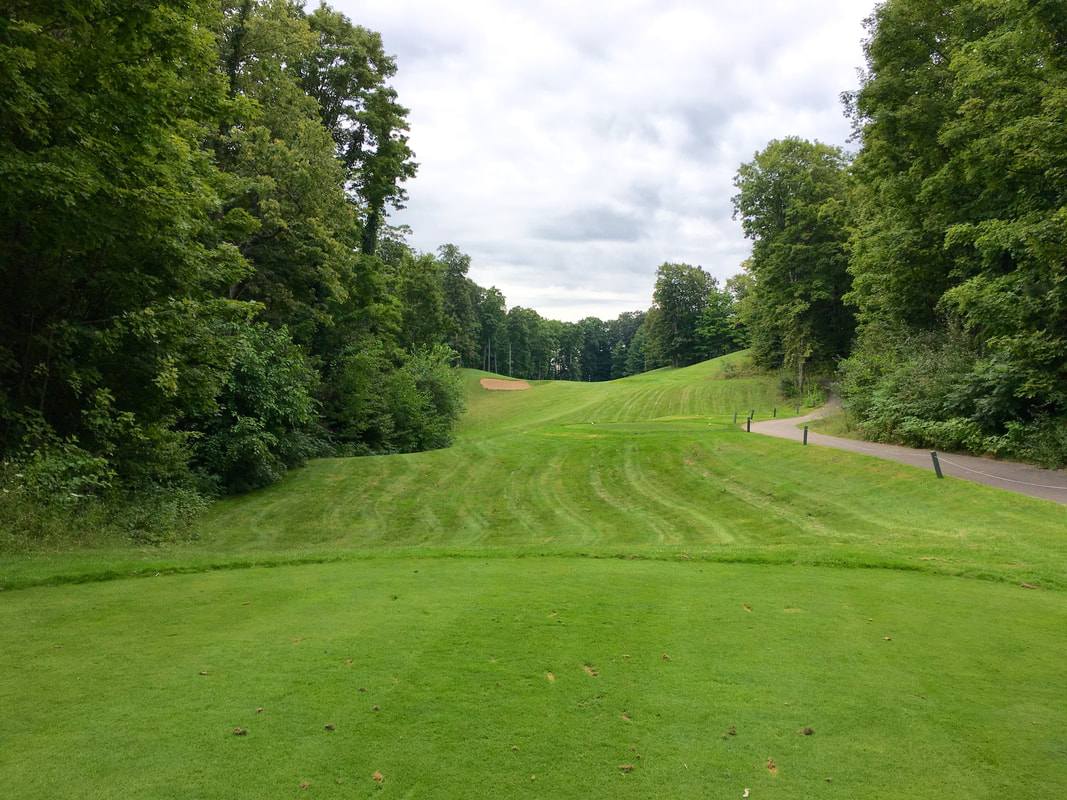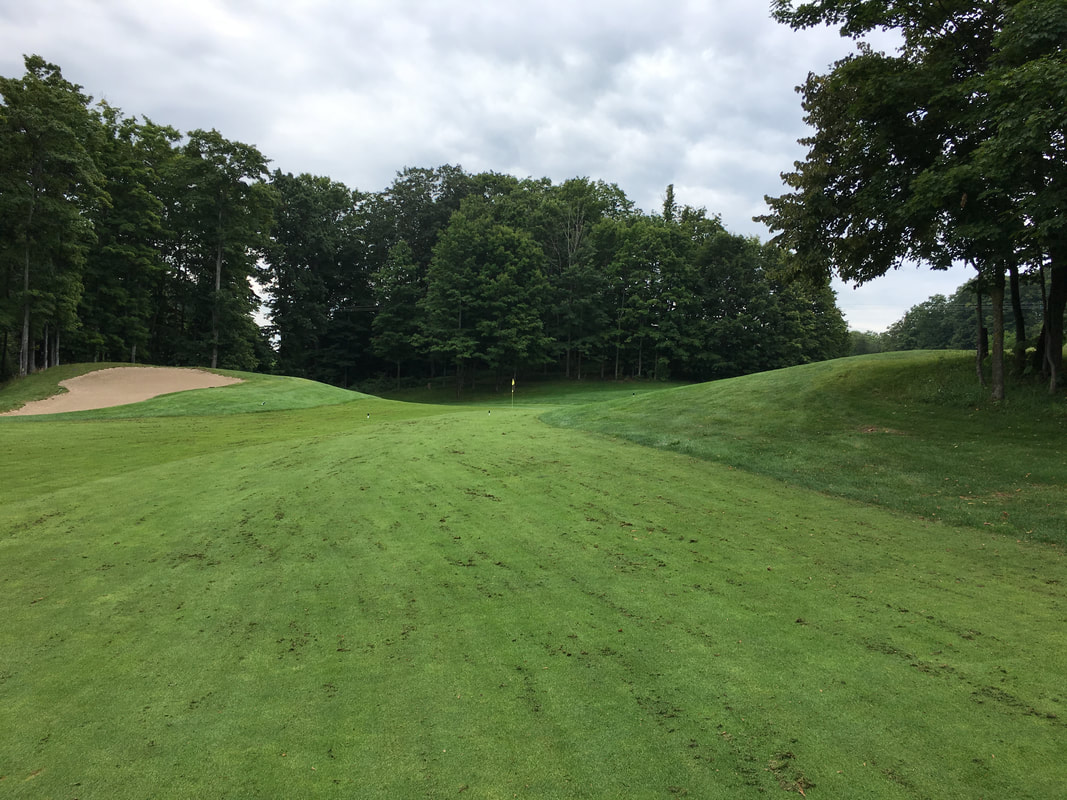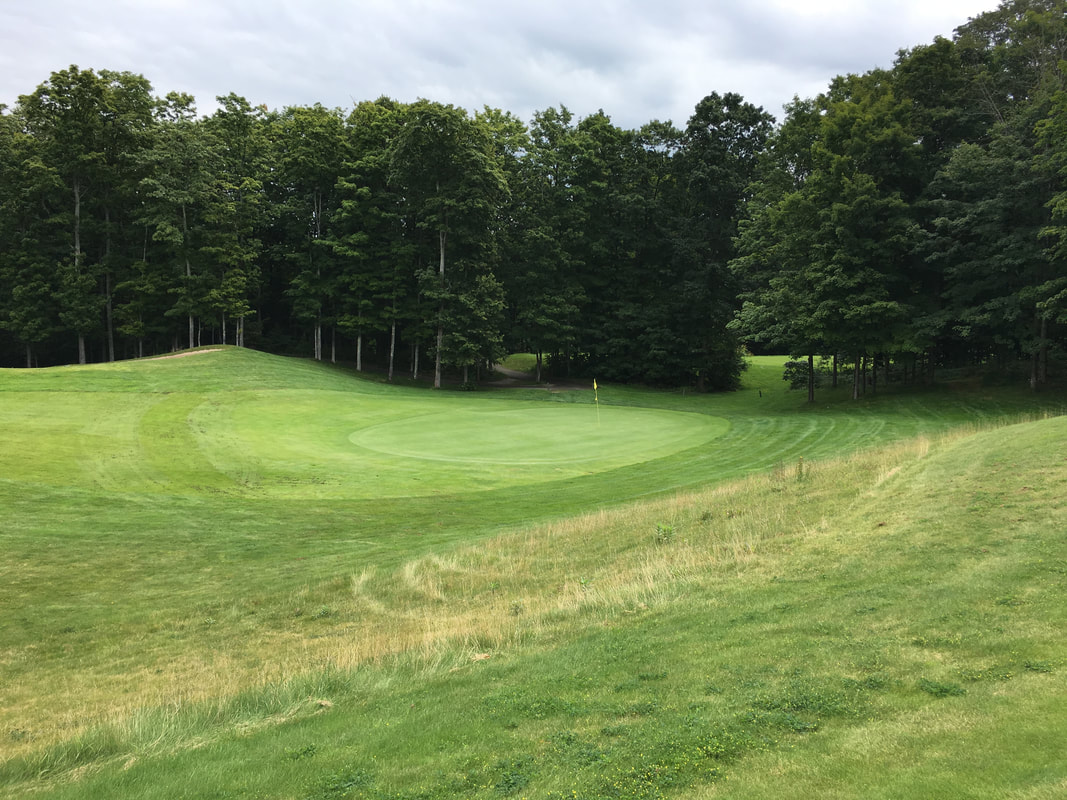One of my favorite things in golf is to find a true hidden gem. Everyone always wants to play the big list courses and those are usually worth the trip, but you go in there with high expectations. Unless they’re really great, you often leave thinking, ‘yeah it was great, but I already knew that it would be.’
But when you come to a course that you know little about, your expectations are modest and could be exceeded by quite a bit. That was the case for me with the Leelenau Club at Bahle Farms. To be fair, my traveling golf buddy—who’s played more Michigan public courses than I have—said that this was his favorite up north. But I’ve never seen it ranked or even mentioned in any golf magazine. So when I was visiting a friend in the Leelenau Peninsula and she suggested that we play golf, I suggested that we come here.
Good choice; not only is Bahle Farms a very good course, it’s easily in my top 20 public courses in the state. The course is nicely routed over hilly (but not mountainous) terrain. The bunkering is well done and the shaping is minimalistic, with greens fitting very well into their surroundings. But, in addition to a few excellent holes, the real standouts here are the green surfaces, which are some of the best in the state. The green contours are broad and wave; not the kind of random, ripply contours that I usually like, but very interesting and challenging. All of it adds up to a beautiful, interesting, and challenging course.
The first tee shot is pleasant enough, downhill to a somewhat saddle-shaped fairway. The green is on a shelf to the right over a deep bunker left, so right-center is the best angle of approach. The par 5 second is the first of several excellent holes. While it could use some tree clearing left of the start of the fairway, there’s plenty of room down there to play to. You can see from the tee that the green angles from front left to back right, so if you’re laying up, you’ll want to do it near the left fairway bunker. There’s also a bunker short right to avoid if you go for the green. But the most notable thing about this hole is the green, which generally slopes back to front, but with several little humps around the edges. There’s also a short grass collection area to the left if you pull your approach. This is one of the best par 5s in the state.
But when you come to a course that you know little about, your expectations are modest and could be exceeded by quite a bit. That was the case for me with the Leelenau Club at Bahle Farms. To be fair, my traveling golf buddy—who’s played more Michigan public courses than I have—said that this was his favorite up north. But I’ve never seen it ranked or even mentioned in any golf magazine. So when I was visiting a friend in the Leelenau Peninsula and she suggested that we play golf, I suggested that we come here.
Good choice; not only is Bahle Farms a very good course, it’s easily in my top 20 public courses in the state. The course is nicely routed over hilly (but not mountainous) terrain. The bunkering is well done and the shaping is minimalistic, with greens fitting very well into their surroundings. But, in addition to a few excellent holes, the real standouts here are the green surfaces, which are some of the best in the state. The green contours are broad and wave; not the kind of random, ripply contours that I usually like, but very interesting and challenging. All of it adds up to a beautiful, interesting, and challenging course.
The first tee shot is pleasant enough, downhill to a somewhat saddle-shaped fairway. The green is on a shelf to the right over a deep bunker left, so right-center is the best angle of approach. The par 5 second is the first of several excellent holes. While it could use some tree clearing left of the start of the fairway, there’s plenty of room down there to play to. You can see from the tee that the green angles from front left to back right, so if you’re laying up, you’ll want to do it near the left fairway bunker. There’s also a bunker short right to avoid if you go for the green. But the most notable thing about this hole is the green, which generally slopes back to front, but with several little humps around the edges. There’s also a short grass collection area to the left if you pull your approach. This is one of the best par 5s in the state.
The third is a bit awkward: a dogleg left short par 4 with a reverse camber fairway. You have to be very careful with this tee shot as it’s easy to lose a ball if you get too aggressive. The second shot is uphill to a heavily contoured green in a bowl. A very tricky hole, especially for first time players, but the visuals are good enough so that it doesn’t seem gimmicky.
The par 3 fourth is very tough but for my liking, one of the better looking pond holes that I’ve seen. It’s all carry to the green, but the green is very attractive, sitting in a saddle at the base of a forested hill. The dogleg left par 5 fifth is also a bit awkward, but the visuals here are worse than the third. Anywhere in the fairway is fine, but the hole can play quite long if you keep it to the right. The second is a lay-up short of the ravine in front of the green, which is framed by cherry trees.
The par 3 sixth is sort-of a redan green, higher on the right than on the left and with contours that allow you to feed the ball to back left hole locations. The seventh is an excellent, medium-length, uphill par 4. The tee shot is pretty wide open but it’s clear that the hole narrows as you approach the green, so this limits how much you can spray it. Plus, the green clearly angles from front left to back right, so a shot up the left side is preferred. The approach is very difficult—it plays at least one club uphill and the green is convex, sloping off in the front, right, and back. A miss short is alright and a close miss right will get hung up in green side rough. But as with several other holes, the real star here is the green, which is very wavy and has a big ridge running across the middle from left to right. The ridge broadens to become a fairly large back right tier (where our pin was). This green exemplifies the greens at Bahle Farms, which are often very undulating, but always give you a decent amount of room to play to around pin positions and safe misses around the greens.
You can also see the green on the downhill par 4 eighth and once again, it’s clear from the front-left to back-right orientation of the green that you’ll want to play up the left side. After a bit of a cart ride uphill through the woods, we come to the par 3 ninth, with a green shelved into a hillside. This isn’t my favorite hole as it feels like it belongs on one of the many poorly routed northern Michigan with poorly chosen, severe green sites. But it’s the only green on the course like this, so it’s forgivable.
Running parallel to the first on its left, the tenth is a pretty wide open and straight forward hole. The eleventh is a northern Michigan special…the drop shot par 3. I actually like this one a lot because there’s plenty of room to miss short. That’s important because when you’re going 75 feet downhill, it’s difficult to judge how far the ball will fly.
After an uphill right doglegging par 5, we have a bit of a change of setting: a long par 4 through a cherry orchard. This fairly flat hole is nevertheless interesting because the right fairway bunkers guard the best line to the green, which has a single bunker on its left. The long par 4 fourteenth is also very interesting. The tee shot could use a bit of tree trimming, especially on the hill on the left. But there’s plenty of room out there and a good tee shot sets up a very elegant looking second shot over a ravine and two bunkers. The shot also plays very well because there is ample short grass short and left and the contours slope toward the green, allowing you to run the ball onto this small green.
The par 3 fifteenth shouldn’t be too hard—there’s plenty of room up there. But if you miss short, the fall will come back a good 10 yards. The par 5 sixteenth doglegs right around a hill. You’ll want to hit a good tee shot here so that you can be sure that you can get your second up the hill and through the saddle. There are no bunkers for the last 2/3 of the hole and it doesn’t need them; the hole falls beautifully across the land and the pinching of the lay-up area with trees right and left creates demand for accuracy. And again, the green sits very simply on the land.
The short par 4 seventeenth has a bit of an awkward uphill drive into another saddle-shaped fairway. But the hole balances with awkwardness with another very simple green site, which is one of my favorite in the state. It doesn't look like they moved any dirt to build this green. Bahle Farms is on a great piece of land but the course shows that if you do a careful job of routing the holes, you can have beautiful, simple green sites where you don’t have to move a lot of earth, saving a lot of money and creating something in harmony with, rather than fighting its surroundings.
The par 4 last features a very challenging approach up a hill to another heavily contoured green. It’s a fitting conclusion that captures the course well—very pretty, challenging without being too difficult, and with an excellent set of greens.
While Bahle Farms may not be as strategic as, say the South Course at Arcadia Bluffs, the greens are as interesting as just about any Michigan public course and the choice of green sites and shaping around the greens show that the designer (and I don’t know who that was) really knew what he was doing. This course is probably the closest thing to Tom Doak’s sadly defunct High Pointe in Traverse City. It exemplifies his style of design nicely, with minimal shaping around the greens and fairways and emphasis on the contour of the green surfaces.
All in all, Bahle Farms is as good as anything in northern Michigan, save for maybe the top tier place like Arcadia Bluffs and Forest Dunes. Given that it’s cheaper than almost all of them, it’s definitely worth a play if you’re near Traverse City.
All in all, Bahle Farms is as good as anything in northern Michigan, save for maybe the top tier place like Arcadia Bluffs and Forest Dunes. Given that it’s cheaper than almost all of them, it’s definitely worth a play if you’re near Traverse City.
























 RSS Feed
RSS Feed